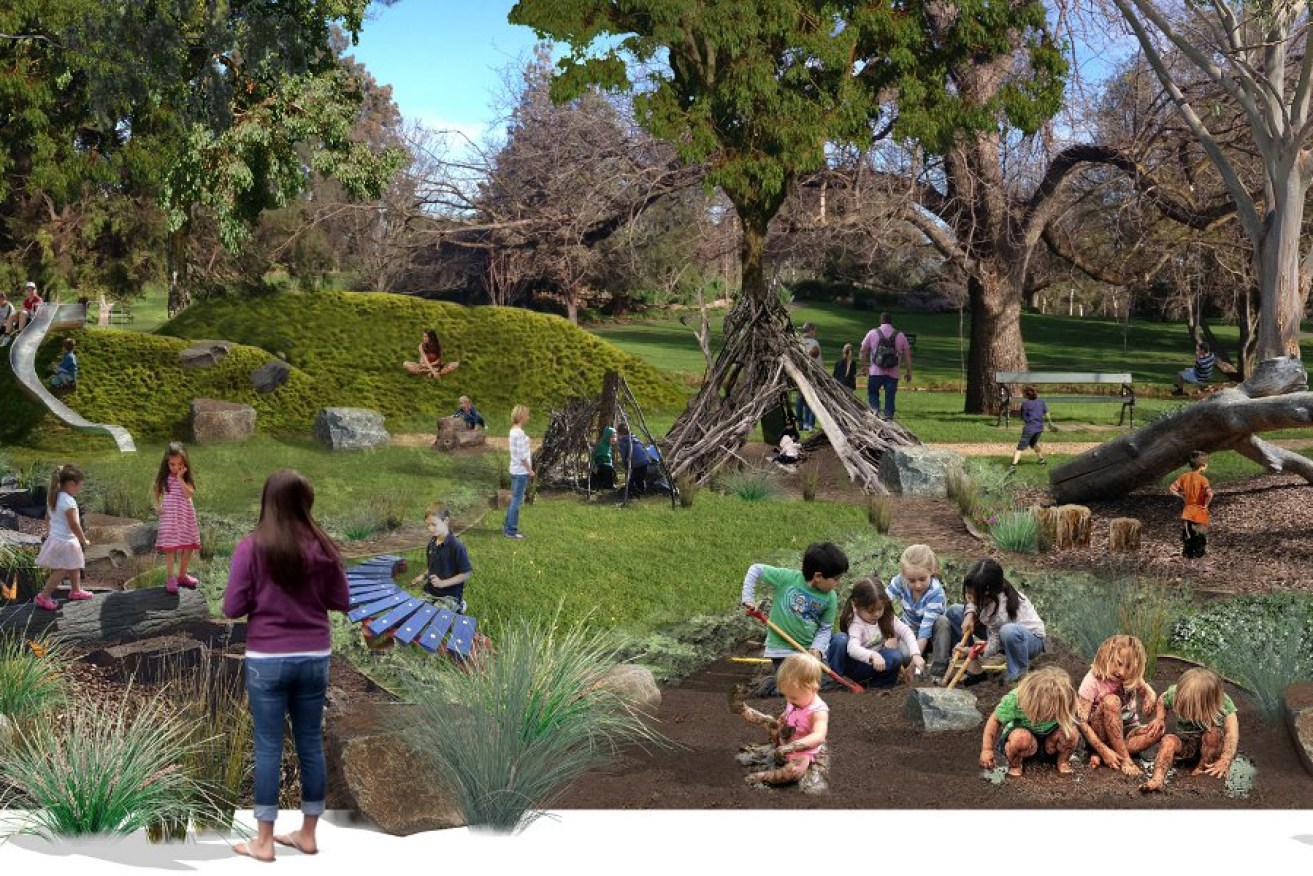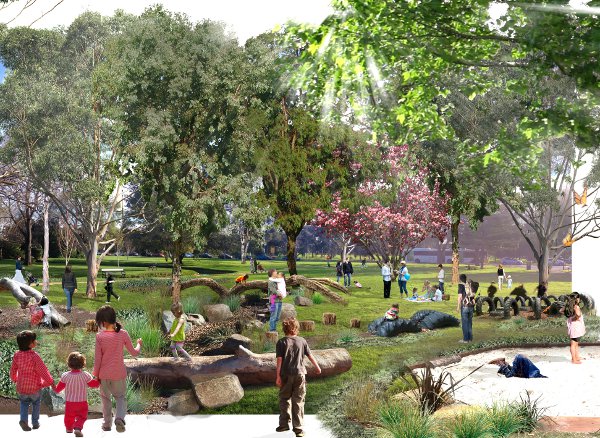Modern playgrounds full of flaws

A render of a natural playground. Artist: Alex Ricketts
Adelaide is at a playground crossroads. Let’s not be left behind to play catch-up. Let’s act to ensure the philosophy of natural play is endorsed and implemented by councils throughout our state. The quality of life for our children and the survival of nature is at stake.
Children’s exposure and access to natural play environments in urban areas is eroding fast or is even non-existent. There is also a cloud of fear in society which has led to children’s freedom to roam being constrained due to a perception of danger echoed in the media and spread by hyper-anxious parents.
Modern playgrounds have many flaws. And it’s not just kinks in the steel – the experiences children have in playgrounds echo loud throughout their lives and have a profound effect on their development. It is imperative we get them right.
Modern platform playgrounds are designed to minimise risk. The challenges set are often repetitive and unimaginative in nature; children are faced with gaudy colour schemes, steps equally spaced, and climbing nets and walls with standard spacing and sizes for hands and feet.
Many playgrounds fail to make provision for all age groups, often because doing so can be expensive. What then tends to happen is that older children dominate the equipment to the detriment of the younger kids, meaning parents constantly have to hover and supervise – the classic helicopter parent.
Another flaw of modern playgrounds is the requirement for every piece of equipment to have an invisible field called a fall zone – an imaginary offset from the equipment that indicates your field of fall. The concept makes sense, but these are often over-designed and result in expansive playgrounds covered by a wilderness of expensive softfall, limiting opportunities, interest and density of playground equipment.
Let kids get dirty
Despite all the attempts at risk minimisation, injuries on playgrounds continue to climb. Why? I believe it’s associated with how children manage risk – or, in fact, don’t manage risk, as they feel that the playground is too safe and lose focus on what they’re doing.
“Nature play” is a more inclusive and collaborative philosophy. It is styled as co-operative learning through play. Children show more empathy for each other and it is proven that long-term exposure gives a sense of wellbeing and calmness .
What goes into a natural playground? Don’t laugh, but it’s nature – and lots of it.
It’s about creating an interactive experience for children so they can enjoy the freedom to roam, unhindered and cajoled by meddling parents.
That’s why these playgrounds may not be to every parent’s liking, as their children will fall, scratch and bruise, get dirty and wet, and eat lots of dirt and bugs.
It’s all about stimulating the five senses, using every part of your body and role-playing and imagining.
A river stone could be a pretend cake or act as currency; you can build cubbies out of branches, swing and climb through the trees, swim and splash in a billabong. You know the orang-utan enclosure at Adelaide Zoo, the one that gives the animals plenty to see and do and experience? That’s ideal – minus the orang-utan, of course.
Our new playgrounds will need warning signs up at the entries; not about the kids getting hurt, but for parents not to naturally hover. If you don’t like it, you have plenty of other playgrounds to go to.
A purist nature playground doesn’t stock the traditional playground elements of swings, slides, spinners and space nets. To the designers of these playgrounds, nature has kindly manufactured and supplied a multitude of exciting elements that don’t require batteries or chargers. Parts are easily replaceable – even self-producing.
A higher level of design thought is required, as we still have to design for compliance and standardisation. But we are capable of integrating these so we understand alternatives and maybe there’s some bending of the rules to provide a play space that is visually representative of nature. The aim is for a landscape that includes risks that offer benefits – meaning kids can get hurt to a degree that allows them to understand the risk to themselves, a fundamental in developing as an individual.
The question of safety
As a parent, the last thing that I want to see happen is kids getting hurt. Therefore the design should consider the age groups of the different users. This can be done by designing element for ability: for example, a two-year-old is not capable of climbing a rock that is a metre high and is intended for a five-year-old.
The disclaimer to parents is that this is a representative of nature and holds facets of risk that cannot be controlled. If you can’t comprehend this, you should also believe that bushland, beaches, rivers and creeks should be fenced off for the survival of the human race.
I mentioned local government at the start of this article because it will play a big role in the revolution I’ve got brewing. But first, it’s worth understanding the role it played in creating the problem in the first place.
Traditionally, councils feel restricted by the threat of litigation and the intrinsic need to ensure the maintenance of playgrounds does not become an annual burden to the ratepayer.
Platform playgrounds have tended to be favoured by councils over the last 40 years because most come ready certified by the manufacture. The fear of being sued is governing the playground experience, but the question needs to be asked: does this risk aversion outweigh the benefits to childhood development?
Councils and designers may stall at the initial concept of a natural playscape, as guidelines and standards aren’t specifically written to cover the provision of natural play, but they simply need the right skillset to interpret the standards and understand in detail the materials they are dealing with.
The Southern Parklands could support a nature playground without it impacting on other users. The area also has the advantage of accessible transport and cycle networks within an easy walk – plus it provides a readily established residential influence from within the CBD and neighbouring suburbs. The most obvious advantage is that there are schools and community groups nearby that can use the playground as part of the learning curriculum through play-based learning.
To stay in touch with Peter’s vision, you can like his Facebook page – Nature Play SA.
Peter Semple is a registered landscape architect, associate & team leader urban design & landscape architecture, at Swanbury Penglase.





